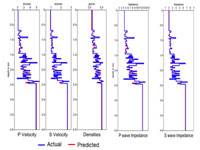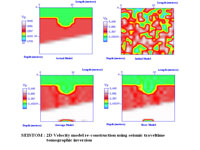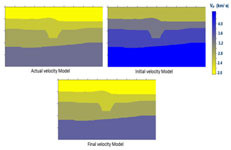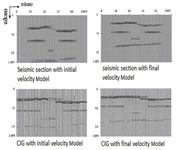Seismic inversion
Seismic Inversion aims at obtaining quantitative estimate of subsurface rock-properties such as P-wave velocity, S-wave velocity and density etc. It is basically an optimization problem, which minimizes the difference between observed and modeled seismic wave traveltime/amplitude or both, while updating the intial estimate of parameters. Seismic inversion starts with an initial model estimate and recorded seismic data. In the process of inversion, synthetic seismic data is generated using forward modeler and is compared with input seismic data. Initial model is iteratively updated till good match is obtained between synthetic and input seismic data. This problem is highly non-linear in nature due to the number of parameters involved. Two major components of seismic inversion are optimization technique and forward modeling method. There are two broad classification of optimization techniques, they are gradient based methods like, least-square, conjugate gradient, quasi-linear newton method etc. and stochastic methods like monte-carlo, simulated annealing, genetic algorithms, ant colony optimization etc. The choice of forward modeler depends upon the type of inversion to be performed. For seismic full waveform inversion, convolution/reflectivity/acoustic/elastic modeling are used. For tomographic traveltime inversion, eikonal solvers/ray tracing methods are required. For velocity model building/inversion, migration method like RTM is required. Since, synthetic seismic data is computed every iteration, seismic inversion is highly compute intensive process. The requirement of computing resources increases with increase in the size of input data 1D to 2D to 3D and from poststack to prestack data and choice of forward modeler.
At CDAC, we have developed seismic inversion applications using optimization methods such as parallel Generalised Linear Inversion (GLI) using least square, parallel conjugate gradient and parallel Real Coded Genetic Algorithm (RCGA) & Binary Coded Genetic Algorithms (BCGA). We have developed 1D seismic full waveform inversion, named as "INVWAV" using offset data in order to determine (P-Velocity, S-Velocity and Density) in time domain, using Multiple Realisation of Real Coded Genetic Algorithm (MR-RCGA) and GLI. INVWAV software can be executed using either Elastic Impedance or Reflectivity Modeling as forward modeler and has been optimized to be suitable for hybrid computing platform using MPI+OpenMP. This application is highly compute intensive in nature due to the number of forward modeling computions involved per iterations. It has capacity to work with large number of unknown parameters and with poor initial guess also.
We have also developed an efficient and robust two-dimensional seismic traveltime tomographic inversion scheme named as “SEISTOM” using RCGA. Here, the forward modeler is First arrival travetime software known as “FAST”. This application is highly compute intensive, because traveltime computation is required to be done for thousands of models. MPI is used for the computation of traveltime over the number of processors. SEISTOM can work for large domain problem and the efficiency & speedup is achieved by keeping the compute to communication ratio high.
Another application for 2D Migration Velocity Analysis (MVA) using parallel RCGA known as "SeisMVA" has been developed and executed on PARAM Series of supercomputers. This application inverts a 2D velocity model using Kirchhoff depth migration generated common image gathers. Here, we pick the horizons from zero-offset migrated sections and vary only the interval velocities within those boundaries. This application is also very compute intensive like the other two applications. The parallelization approach here is similar to the SEISTOM software.
Currently, we are involved in enhancement of INVWAV software for 2D acoustic inversion suitable for current class of multicore and manycore architecture. We would also focus on 2D RTM based inversion method for seismic data using state of the art architecture of PARAM series of supercomputer.
Contact Person
Ms Richa Rastogi
(Associate Director)
Email: richar[at]cdac[dot]in, contactsdp[at]cdac[dot]in





